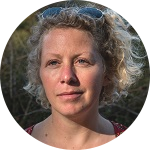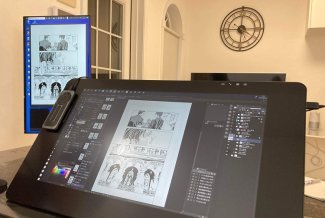In this photograph, taken on 11 February 2020, Marjolein Jonker, one of the pioneers of the tiny house movement in the Netherlands, stands in front of her home in the Dutch city of Alkmaar.
“I used to live in a standard single-family house, but in 2016 I had the growing feeling that I wanted to change my lifestyle. I dreamt of living in a small house, surrounded by nature and without the financial burden that leaves little room for freedom to chase my other values,” says Marjolein Jonker, the first person to build a ‘tiny house’ in the Netherlands. “When I started blogging about my experience of constructing a tiny house and the challenges I faced finding a plot to build on, I would have never expected that it would grow into a movement.”
There are no specific rules for a tiny house: some are on wheels, others are fixed; some owners self-design and self-build, others work with an architect or even opt for a prefab; but all are underpinned by a commitment to living with as small an ecological footprint as possible and without the huge debt that comes with a mortgage on a conventional home. In the Netherlands, tiny homes are generally between 15m² and 50m², and as Dutch building regulations make it difficult for tiny housebuilders to find a permanent spot to live, most are built on a trailer, as they need to be movable.
Today, Marjolein lives by herself in a tiny house community of five dwellings, right next to a little lake on the outskirts of Alkmaar, a city in northern Holland. Chickens potter about in Marjolein’s garden as a neighbour passes by to empty her compost toilet – just one of the perks that comes with off-grid living. “It makes us more independent. It also makes you super conscious of the amount of water and energy you consume,” says Marjolein, who offers advice and spreads the gospel of the movement through the Tiny House Nederland project. Rainwater is filtered and used for drinking, cooking and showering, while solar panels harness the energy of the sun, which can be a challenge in the winter “as the Netherlands does not really have a Mediterranean climate,” Marjolein quips.
With over 17 million inhabitants packed into 41,543 km², the Netherlands is one of Europe’s most densely populated countries. Unsurprisingly, tiny houses are becoming an increasingly popular way of living, with an estimated 500 tiny houses across the country and close to 27,000 members of the Tiny House Nederland Facebook group, where people can discover the ways in which they too could live tiny.
The concept of ‘going tiny’ originates from the United States where people have been downsizing their homes for decades. In the aftermath of Hurricane Katrina, so-called ‘Katrina cottages’ were designed to provide people with quick and cheap new housing. The economic crisis in 2008 further reinforced the popularity of tiny houses in the US.
Of the surging popularity of the tiny house movement in the Netherlands, Marjolein says: “People have the time and ability to reflect on the limitations of economic growth. At the same time, they are used to a certain level of luxury. Tiny houses are qualitatively of a high standard and design.”
Elvie Kromwijk, who has lived for almost a year with her partner Abel in a ‘tiny village’ in the southern city of Delft expands further: “We live in a privileged society but the younger generation especially are starting to question traditional values like the current economic model. The mentality is changing, and people are more concerned with the environment. Sustainability has become a core value.”
Popularity, challenges and opportunities
Architect Jan-Willem van der Male runs the Tiny House Academy in Rotterdam, where he teaches people how to design and build their own homes. “Instead of building houses for others, I want people to become responsible for their own choices, so I teach them the ins and outs of building a tiny house.” He says the rational, calculated nature of Dutch people has contributed to the growing popularity of the movement in the country. “It is in our mentality to calculate what we need and what we spend, and tiny house living derives from the idea that you just use what you need, and nothing more.” Another alluring aspect he mentions is the creative freedom one experiences as a builder. “You can make your home look like a suitcase, or a doll’s house. Everything is possible.”
Affordability plays a role too. To complete a tiny house, including water and energy systems, it can cost anywhere between €50,000 and €100,000. In a densely populated country like the Netherlands, where the price of both houses and land are continuously rising, the tiny price point is incredibly enticing. Former Amsterdam resident Elvie explains how she and her partner Abel struggled to find a conventional solution when looking for a place together. “With our incomes, we were not eligible for social housing, but we could not afford to buy an apartment or house in the city either. Renting in the private sector is also too expensive, so we started to look for alternatives.”
Karin Prins, a married mother-of-two who now lives in a 24 m² tiny house in the forest near Zeist (just east of Utrecht), says that she also joined the movement because it allowed her to live life on her own terms: “We wanted to be more free,” she tells Equal Times. “I had a demanding job as a communication expert, and I felt that my life would collapse like a house of cards if anything went wrong. Now I work as a freelance copywriter, which gives me much more room to take care of my children.”
However, the tiny house movement is not for everybody. Minimalist, ecological and economical values are intertwined: “If you are not fully committed, you can’t make it,” says Jan-Willem of the Tiny House Academy. Marloes van der Gulik, one of Marjolein’s neighbours in Alkmaar, admits that she never planned to live off-grid. “It just came with the package. I wanted to live small, with nature around me, and I found a way through the tiny house movement. Being independent from everything and being able to live anywhere, even if there is no water or sewer system is great, but sometimes it is frustrating when you can’t heat your shower or when you have to carry your shit to the compost.”
There is one major challenge to the tiny house movement in the Netherlands: “Land is scarce, expensive and rarely for sale,” says Marjolein. In addition, Dutch laws provide strict guidelines on the safety, construction and usage regulations that homes must meet in order to obtain permanent residence.
According to Karin, it is nearly impossible to build tiny houses for permanent residency because of legal limits for the minimum size of a permanent dwelling. However, as the movement grows, and policymakers and municipalities learn about its benefits, more and more land is becoming available to tiny housebuilders. “You need some perseverance to find a place for your house, but it is possible,” says Marjolein. Karin agrees: “Municipalities are often sceptical in the beginning, but when they see that we are just normal people who want to keep the place tidy and just want to stretch the rules, they often see the opportunities and they give us a temporary place where the houses can stay for 5 or 10 years. It is also a reason why the houses are built off-grid and why most of them have wheels – you never know where you will move to afterwards.”
Since the COVID-19 outbreak began, people everywhere have been spending a lot more time in their homes, with stay-at-home orders making it the place where many people now spend all of their work and leisure time. Karin is often asked if it is difficult to live in a tiny house with a family of four during the coronavirus lockdown, but she says the opposite is true: “People think our house is too small for confinement, but we can’t imagine a better place. Our garden is huge and it is spring now. We have organised home-schooling within the community, so everyday another parent is taking care of all the children, which makes it easier to work from home.”
The only challenge Elvie faces working from home is the limited space. “But with clear appointments with my partner, who also has to take part in Zoom meetings for work, it is absolutely possible.” She also appreciates the support she gets from her neighbours: “I think many people can feel isolated and lonely, but we have a lot of contact with the other inhabitants of our tiny house community.”
Is the pandemic likely to have a positive impact on the future of the tiny house movement? Marjolein thinks so: “Since the COVID-19 outbreak, more people have registered an interest in living in a tiny house. The corona-crisis reaffirms the sentiment that things cannot continue as they are. People are becoming increasingly conscious that the world has to change. And I expect the economic crisis that will follow will also have an impact on the tiny house movement. The last economic crisis created space for experimental building. Municipalities were more open to provide permission for temporary housing and new forms of living. I hope and expect that this will happen again.”










